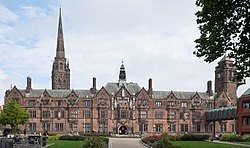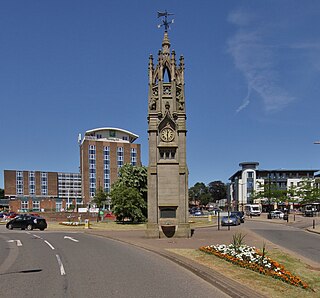
Kenilworth is a market town and civil parish in the Warwick District in Warwickshire, England, 6 miles (10 km) south-west of Coventry, 5 miles (8 km) north of Warwick and 90 miles (140 km) north-west of London. It lies on Finham Brook, a tributary of the River Sowe, which joins the River Avon 2 miles (3 km) north-east of the town. At the 2021 Census, the population was 22,538. The town is home to the ruins of Kenilworth Castle and Kenilworth Abbey.

In local government, a city hall, town hall, civic centre, guildhall, or municipal building is the chief administrative building of a city, town, or other municipality. It usually houses the city or town council, its associated departments, and their employees. It also usually functions as the base of the mayor of a city, town, borough, county or shire, and of the executive arm of the municipality.

Coventry, a city in the West Midlands, England, grew to become one of the most important cities in England during the Middle Ages due to its booming cloth and textiles trade. The city was noted for its part in the English Civil War, and later became an important industrial city during the 19th and 20th centuries, becoming the centre of the British bicycle and later motor industry. The devastating Blitz in 1940 destroyed much of the city centre, and saw its rebuilding during the 1950s and 60s. The motor industry slumped during the 1970s and 80s, and Coventry saw high unemployment. However, in the new millennium the city, along with many others saw significant urban renaissance and in 2017 it was announced that the city had been awarded the title of 2021 UK City of Culture.

The Civic Centre is a municipal building located in the Cultural Quarter area within the city of Southampton, England. It comprises offices occupied by Southampton City Council, the SeaCity Museum, the Guildhall, the Southampton City Art Gallery, and the city library. It was designed by the English architect Ernest Berry Webber in the Classical style in 1929 and constructed over a ten-year period. It was completed in 1939. Pevsner's Hampshire: South describes it as "the most ambitious civic building erected in the provinces in the interwar years". It was designated as a Grade II* listed building in 1980.
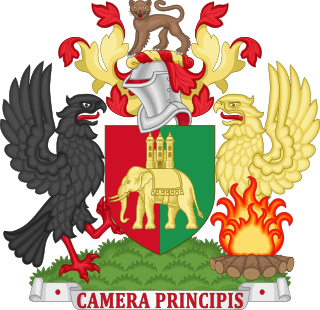
Coventry City Council is the local government body responsible for the governance of the City of Coventry in England, which has been a metropolitan district since 1974.

The Guildhall is one of the main office buildings of the City and County of Swansea Council. The Guildhall complex, which includes the City Hall, Brangwyn Hall and the County Law Courts for Swansea, is a Grade I listed building.

Portsmouth Guildhall is a multi-use building in the centre of Portsmouth, Hampshire, England. It is located in a pedestrian square close to Portsmouth and Southsea railway station. Constructed in 1890, the building was known as Portsmouth Town Hall until 1926. It was heavily damaged by bombing during the Second World War and largely rebuilt during the 1950s by the English architect Ernest Berry Webber. It now operates as a concert, wedding and conference venue. It is a Grade II listed building.

Leicester Town Hall stands at Town Hall Square in the city centre of Leicester, England. The building, which is the meeting place of Leicester City Council, is a Grade II* listed building.

Norwich City Hall is an Art Deco building completed in 1938 which houses the city hall for the city of Norwich, East Anglia, in Eastern England. It is one of the Norwich 12, a collection of twelve heritage buildings in Norwich deemed of particular historical and cultural importance. It was designated as a Grade II* listed building in 1971.

The Guildhall is a building on Alfred Gelder Street in the City of Kingston upon Hull, East Riding of Yorkshire, England. The building is currently the headquarters of Hull City Council but is also used as a venue for conferences, civic receptions and formal dinners. It is a Grade II* listed building status.

Norwich Guildhall is a municipal building on Gaol Hill in the city of Norwich, United Kingdom. It is a Grade I listed building.
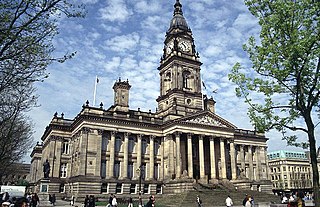
Bolton Town Hall in Victoria Square, Bolton, Greater Manchester, England, was built between 1866 and 1873 for the County Borough of Bolton to designs by William Hill of Leeds and George Woodhouse of Bolton. The town hall was extended in the 1930s to the designs of Bradshaw, Gass and Hope and has been designated a Grade II* listed building by English Heritage.
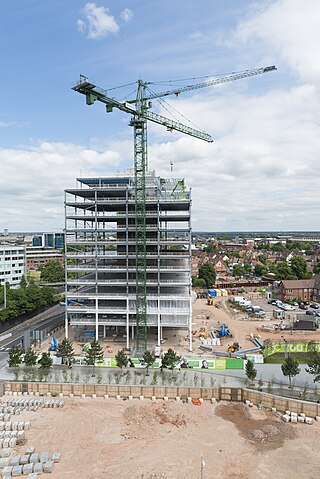
Friargate is a business district in Coventry. Covering 37 acres (15 ha) surrounding Coventry railway station. It is made up of 25 new buildings, including 14 Grade A office buildings, two hotels and new homes.

Plymouth Civic Centre is the former headquarters of Plymouth City Council on Armada Way in Plymouth, Devon, England. The building is in two sections, comprising a 14-storey tower block which housed the council's offices, and a two-storey southern wing called the Council House which includes the council chamber and is linked to the tower block by a bridge at first floor level. The building was completed in 1962. The council sold the tower block part of the building in 2015, but the Council House remains the council's meeting place. The whole complex has been a Grade II listed building since 2007.

Plymouth Guildhall is located on Guildhall Square in the city centre of Plymouth, Devon, England. It is a Grade II listed building.

Leamington Spa Town Hall is a Grade II listed municipal building located in the town of Leamington Spa in Warwickshire, England. It is the meeting place of Royal Leamington Spa Town Council.

The Guildhall is a municipal building in High Street, Newcastle-under-Lyme. It is a Grade II listed building.

Launceston Guildhall and Town Hall is a municipal building in Western Road in Launceston, Cornwall, England. The building, which was the meeting place of Launceston Town Council, is a Grade II listed building.

Oswestry Guildhall is a municipal building in Bailey Head in Oswestry, Shropshire, England. The structure, which was the meeting place of Oswestry Municipal Borough Council, is a Grade II listed building.

Liskeard Guildhall is a municipal building in Pike Street, Liskeard, Cornwall, England. The structure, which was the meeting place of Liskeard Borough Council, is a Grade II* listed building.
